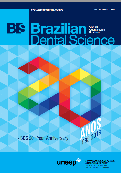Influence of illuminants and different observers on the perception of surface gloss of resin composite
DOI:
https://doi.org/10.14295/bds.2018.v21i4.1648Abstract
Objective: To evaluate the visual perception of surface gloss of resin composite under different illuminants by different observers. Material and methods: twelve cylindrical specimens (6mm x 1mm) were fabricated using a nanofilled resin composite (Z350, A2E shade) in order to compare different observers and to determine the limit of perceptibility of surface gloss. Bovine tooth specimen with similar dimensions was obtained for the comparison of different illuminants. Polishing of resin specimens was performed resulting in 6 groups, presenting surface gloss values at 10, 25, 40, 55, 70, and 85 GU (gloss units), measured by glossmeter (NOVOCURVE). Fifteen individuals were selected: 5 lay-person, 5 undergraduate students, and 5 dental professionals. Participants observed the specimens in a light booth (Gti lightbox) under three different illuminants, and rated the possible combinations between resin specimens or with the bovine enamel specimen (85GU). Data obtained were analyzed by PROBIT non-linear regression analysis (?=0.05). Results: Differences were observed among types of illuminants (p=0.042) and ?GU (p=0.004), with no interaction between factors (p=0.139). The fluorescent light presented lower surface gloss perceptibility values in relation to incandescent light. There was no influence by type of observers (p =0.598). The surface gloss perception limit was 17.6 GU under the presented tested conditions. Conclusion: the illuminant type influenced perception of gloss, with lower percentage of perceptibility for fluorescent light, while such perceptibility was not influence by different observers.Keywords
Illuminants; Observer variation; Composite resins; Surface gloss.
Downloads
Downloads
Published
How to Cite
Issue
Section
License
Brazilian Dental Science uses the Creative Commons (CC-BY 4.0) license, thus preserving the integrity of articles in an open access environment. The journal allows the author to retain publishing rights without restrictions.
=================




























